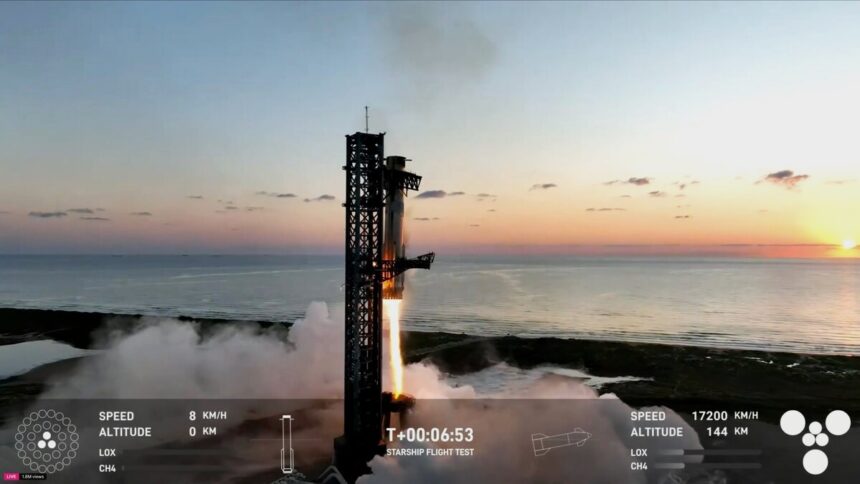On October 13, 2024, SpaceX achieved a significant milestone with the successful launch of its fifth Starship test flight. This ambitious mission represents a critical step toward human exploration of the Moon and Mars, showcasing cutting-edge technology and engineering.
Liftoff and Mission Overview
The launch took place at 8:25 a.m. ET from Boca Chica, Texas’s Starbase facility operated by SpaceX. The Super Heavy rocket booster, topped with the uncrewed Starship spacecraft, lifted off during a 30-minute launch window. Viewers could watch the mission live on X, the social media platform formerly known as Twitter.
This test flight included a complex maneuver: after the Super Heavy booster separated from the Starship spacecraft, it aimed to return to a landing structure at the launch site. In a groundbreaking achievement, the booster was successfully caught midair using a pair of massive mechanical arms, affectionately known as “chopsticks.” While the booster was recovered, the Starship spacecraft continued its flight and planned a landing maneuver over the Indian Ocean, which SpaceX does not expect to recover.

Objectives of the Mission
Each test flight is a step toward SpaceX’s larger goals: recovering and rapidly reusing both the Super Heavy boosters and Starship spacecraft for future missions. Quick reuse of rocket components is critical to SpaceX’s vision of reducing the costs and time involved in delivering cargo and human crews to Earth’s orbit and beyond.
Ultimately, SpaceX aims to use the Starship capsule to transport NASA astronauts to the lunar surface as part of the Artemis III mission, scheduled for 2026. The company holds contracts worth nearly $4 billion for this task and has even more ambitious plans to send humans to Mars.
Watch Starship's fifth flight test https://t.co/LVrCnTv797
— SpaceX (@SpaceX) October 12, 2024Evolution of Starship Development
SpaceX’s development of Starship has been marked by increasingly complex test flights. The journey began in 2019 with initial hop tests of a vehicle called “Starhopper,” which lifted only a few inches off the ground. The first integrated test flight of the fully stacked Starship and Super Heavy occurred in April 2023, successfully launching but ending in an explosion minutes later.
Despite these setbacks, SpaceX has a history of embracing failures as learning opportunities. Each setback provides valuable data, allowing the company to implement design changes quickly. As the complexity and ambition of missions have grown, the results have reflected that progress.
The previous test flight in June saw both the booster and spacecraft survive reentry into the atmosphere and practice touchdown maneuvers over the ocean. This progress was crucial for preparing for the more challenging tasks ahead.
The Role of “Mechazilla”
A standout feature of SpaceX’s recovery plan is the launch tower known as “Mechazilla.” This towering structure, named by SpaceX CEO Elon Musk for its resemblance to a metallic Godzilla, features massive arms designed to catch and secure the Super Heavy booster upon its return to Earth. Unlike the Falcon 9 rocket, which uses landing legs for recovery, the Super Heavy booster relies entirely on these mechanical arms.
Musk envisions a future where the booster can be caught and turned around for its next flight within minutes of landing, potentially launching again just 30 minutes after touchdown. This level of rapid reusability could drastically change the economics of space travel.
The Super Heavy Booster’s Adventure
During this latest test flight, the Super Heavy booster, known as Booster 12, successfully completed a critical catch just below its grid fins about seven minutes after liftoff. This achievement is essential for SpaceX’s long-term vision of quickly reusing its launch vehicles. The ability to recover the booster at the launch site opens up new possibilities for future missions and could enhance the efficiency of the entire launch process.
Gwynne Shotwell, SpaceX’s president and COO, expressed her excitement on social media, stating, “I don’t know what to say!” as they posted a video of the successful capture. Bill Gerstenmaier, vice president of build and flight reliability, had previously expressed confidence in the catch attempt, highlighting the precision achieved during earlier flights.
The Starship’s Flight Path
The Starship vehicle, referred to as Ship 30, followed a suborbital trajectory similar to the previous flight in June, reaching a peak altitude of 212 kilometers before planning a splashdown in the Indian Ocean. This mission will provide invaluable data as SpaceX prepares for future manned missions and deeper exploration of space.
Navigating Regulatory Challenges
The launch occurred less than 24 hours after the Federal Aviation Administration (FAA) issued a revised launch license, which had been a point of contention for SpaceX. The FAA required updates to an environmental assessment due to changes in the flight profile, including a larger area for potential landing debris in the Gulf of Mexico. This regulatory hurdle highlights the complexities of modern spaceflight, where safety and environmental considerations are paramount.
With the amended license, SpaceX can now launch with a similar profile on at least one more occasion (named Flight 6) without obtaining additional FAA approval. This flexibility is crucial for the company as it aims to accelerate its testing and development timeline.
Looking Ahead
As SpaceX continues to push the boundaries of space exploration, the success of this latest test flight sets the stage for even more ambitious projects. If all goes well, the company will soon tackle the challenges of in-orbit refueling for Starship, an essential step for missions to the Moon and beyond.
However, any failures or significant damage to launch facilities could impact NASA’s timelines for lunar exploration. The Artemis program aims to land astronauts on the Moon for the first time since the Apollo era, and delays in Starship development could ripple through the overall mission timeline.
In summary, SpaceX’s fifth Starship test flight marks a significant advancement in rocket technology and space exploration. Each successful flight brings the company closer to its ambitious goals of returning humans to the Moon and eventually sending astronauts to Mars. With every mission, SpaceX is not only shaping the future of space travel but also igniting public interest and excitement about the possibilities of human exploration beyond Earth.
Read More: Obama Calls on Black Men to Support Kamala Harris






